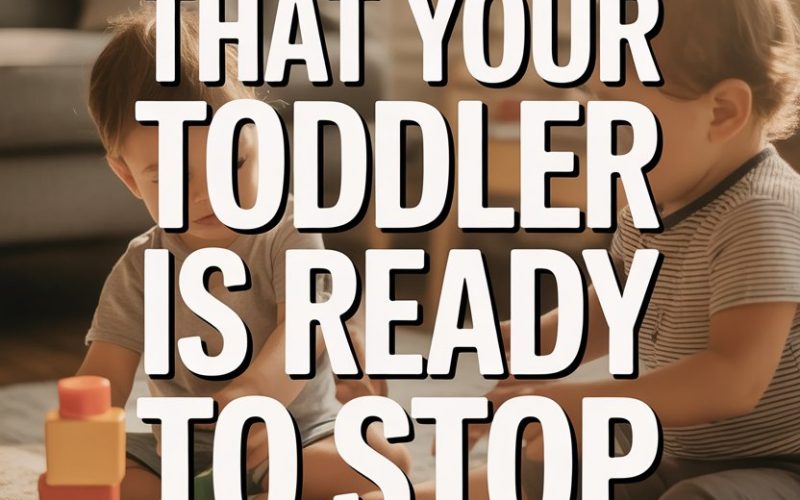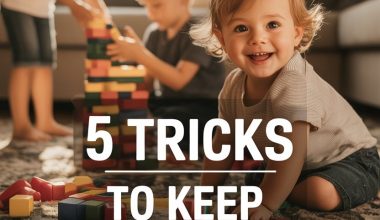One moment you’re tucking a warm, squishy toddler into their afternoon nap, basking in the glorious hush of the house. The next, you’re face-to-face with a pint-sized party animal staging a protest at nap time, hollering that sleep is for the weak.
Ah, the great nap transition: a milestone every parent both dreads and secretly celebrates. But how do you know when your little human is truly ready to bid those daytime snoozes goodbye?
Before anyone panics and hides under the nearest pile of stuffies, let’s get real about what readiness looks like (or doesn’t).
Some parents spot the signs instantly. Others wonder for months if the bedtime shenanigans are a “phase” or a full-blown evolution.
Whichever camp you’re in, it helps to know what you’re looking for—and what’s totally normal.
Nap Refusal Becomes the New Norm
Every toddler skips a nap now and then, usually after eating their body weight in birthday cake or seeing a particularly exciting digger out the window.
But when nap refusal moves from the occasional one-off to a daily routine, something’s up.
You might notice that instead of settling in with their favourite blanket, your child is suddenly incapable of keeping still.
There’s singing. There’s running laps across the cot. There’s the Olympic-level effort to stand on their head. All while you desperately channel your inner zen master.
If this resistance stretches beyond a week or two, and your child seems perfectly chipper afterward, you may be witnessing the start of nap extinction.
Some children simply outgrow the need for daytime sleep sooner than others, and their bodies start to adjust accordingly.
Bedtime Battles or Early Wake-Ups
Toddlers do love consistency—just not with sleep, apparently. When naps start interfering with nighttime slumber, parents are left scratching their heads.
Is your child suddenly taking a full two-hour nap, only to treat bedtime like a casual suggestion? Or is your formerly reliable sleeper up at the crack of dawn, ready to discuss the existential questions of Peppa Pig?
The notorious bedtime pushback or those mysterious early-morning wake-ups often signal that your child’s daytime sleep is robbing their nighttime rest.
Research from the Sleep Foundation confirms that dropping naps can help restore a solid night’s sleep for kids who truly don’t need naps anymore.
If bedtime routines have turned into a 90-minute negotiation (with hostage-level snack demands), a nap adjustment might be in order.
Consistent Energy and Mood
Most toddlers who still need a nap turn into adorable gremlins by late afternoon. If your child skips their nap and then morphs into a cranky, overtired puddle on the floor, napping probably needs to stick around.
On the other hand, some parents are shocked to find their tot manages to power through the day without a meltdown.
If your child skips a nap and is still relatively cheerful, playful, and not picking fights with the cat, there’s a good chance they’re starting to outgrow the nap.
Keep an eye out for patterns over a couple of weeks. The occasional “off” day is normal, but a consistent ability to skip naps without turning into Grumpy McCrankyPants is a positive sign.
Shorter Naps or Taking Ages to Fall Asleep
Gone are the days when you could set your watch by your child’s nap and sneak in a full episode of your favourite (grown-up) show. Some toddlers start taking much shorter naps or seem to lie in bed for ages before they finally crash.
This shift isn’t just a test of your patience. It’s usually a signal that their need for daytime sleep is dropping.
According to Stanford Children’s Health, this gradual decrease in nap duration and the time it takes to settle can stretch for weeks before naps disappear entirely.
If you’re waiting 45 minutes for a 20-minute nap, you’re not alone. And yes, it’s absolutely as maddening as it sounds.
No More Afternoon Zombie Mode
The telltale “witching hour” meltdown is practically a rite of passage for parents. Most toddlers who still need a nap will hit a wall by late afternoon: the whining, the drama, the sudden, passionate hatred for trousers.
But what if your child seems to breeze through, energy levels steady from breakfast right up until bedtime?
For many, this is the holy grail—the moment when you realise you’re no longer living by the clock, terrified of upsetting the nap gods.
Steady afternoons, with no crankiness or dramatic tantrums, are a big hint your child is ready for the nap-free life.
Nap Skipping Doesn’t Lead to Total Chaos
Some days, naps just don’t happen. A loud bin lorry rumbles past at the wrong moment, or the dog barks, or your child decides sleep is for babies (the betrayal!).
The real question: what happens next?
If nap skipping leads to epic meltdowns, dinner disasters, and a bedtime that resembles the final act of a Greek tragedy, napping is still essential.
But if skipping naps has little to no impact on your child’s mood, appetite, or sleep at night, their body may be telling you it’s time to move on.
Try tracking nap-free days in your calendar for a couple of weeks. You might notice a pattern that makes the decision much easier.
Your Child Is Nearly or Over Three
Age isn’t everything, but it does matter. While some children stop napping as early as two, the average age to give up daytime sleep hovers around three to four years, depending on culture, family schedule, and temperament.
Research summarised by HealthyChildren.org shows that roughly half of children are done with naps by age four.
If your child is approaching their third birthday and showing other signs—like nap refusal and steady moods—there’s a good chance it’s time to start phasing out naps.
You’re Getting “Nap FOMO” (and So Are They)
One of the more subtle signs pops up when your child starts noticing what they’re missing during nap time. Maybe they hear siblings playing or spot mum sneaking a biscuit, and suddenly, the nap seems highly overrated.
You’ll know you’ve hit this stage when your child starts lobbying for extra “quiet time” activities or flat-out refuses to miss out on the action, even if they’re a bit tired.
This isn’t all bad—it might be your cue to swap naps for quiet rest, puzzles, or a stack of books. The key is offering downtime, even if sleep’s off the table.
Your Toddler Falls Asleep at Odd Times
Ironically, some kids who are ready to stop napping don’t just skip naps—they start drifting off at the most unpredictable moments. You find them snoozing in the car at 4pm, or face-planted in a pile of Duplo at five.
When naps disappear, the body clock needs time to recalibrate. These “crash and burn” moments can be normal during the transition.
Consider moving bedtime up for a while or creating a quiet rest period to help their body adjust.
Tips to Survive the Transition
Not all children ease out of naps smoothly. There will be wobbly days. Maybe more than a few. Here’s how to ride those waves:
Offer quiet time: Even if your child refuses to sleep, a daily rest period helps everyone recharge. Think soft music, books, or cuddles—anything that doesn’t involve a sugar-fuelled dinosaur parade.
Bump up bedtime: If the afternoons get rough, shifting bedtime earlier (even by 30 minutes) can be a lifesaver while everyone adjusts.
Watch for overtired signals: Some kids act wild when they’re tired, others just melt down. Tailor your evenings accordingly and try not to take the drama personally.
Consistency is your friend: As much as possible, keep routines predictable. Toddlers love structure, even as they fight it with every fibre of their being.
Stay flexible: Some days, they might surprise you by crashing out mid-story. That’s normal. The transition isn’t always linear—think wild rollercoaster, not gentle slip ‘n slide.
The Nap-Free Frontier
Every toddler is unique, and there’s no gold medal for quitting naps the earliest.
Some will hang onto that afternoon sleep like a beloved lovey; others will charge ahead, fuelled by sheer willpower and an endless supply of snacks.
When you spot these signs—steady moods, nap refusal, no afternoon meltdowns—you’ll know your child is likely ready for the nap-free life. There might be bumps. There might even be a few tears (yours, theirs, or both).
But, much like every other parenting transition, you’ll muddle through.
And when you finally reclaim those extra daytime hours, feel free to celebrate with a hot cup of tea—or an uninterrupted trip to the loo.
You’ve earned it.





